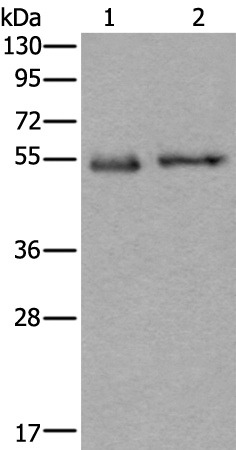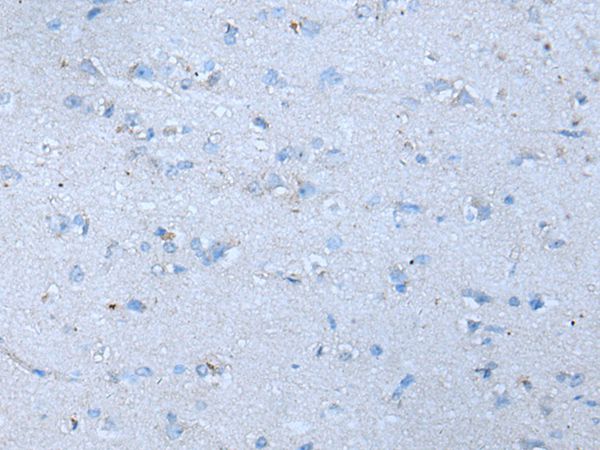

| WB | 咨询技术 | Human,Mouse,Rat |
| IF | 咨询技术 | Human,Mouse,Rat |
| IHC | 1/10-1/50 | Human,Mouse,Rat |
| ICC | 技术咨询 | Human,Mouse,Rat |
| FCM | 咨询技术 | Human,Mouse,Rat |
| Elisa | 咨询技术 | Human,Mouse,Rat |
| Aliases | ATA1; NAT2; SAT1; SNAT1 |
| Entrez GeneID | 81539; |
| WB Predicted band size | 54kDa |
| Host/Isotype | Rabbit IgG |
| Antibody Type | Primary antibody |
| Storage | Store at 4°C short term. Aliquot and store at -20°C long term. Avoid freeze/thaw cycles. |
| Species Reactivity | Human |
| Immunogen | Synthetic peptide of human SLC38A1 |
| Formulation | Purified antibody in PBS with 0.05% sodium azide. |
+ +
以下是关于SLC38A1抗体的3篇参考文献,按您的要求整理:
1. **文献名称**:*SLC38A1 regulates glutamine transport in human astrocytes*
**作者**:Wang Q. et al.
**摘要**:研究通过免疫组化和Western blot技术验证SLC38A1抗体特异性,发现SLC38A1在人星形胶质细胞中调控谷氨酰胺转运,影响神经代谢平衡。
2. **文献名称**:*The role of SLC38A1 in pancreatic cancer progression*
**作者**:Zhang L. et al.
**摘要**:利用SLC38A1抗体进行免疫荧光染色,证明该蛋白在胰腺癌细胞中高表达,并通过促进氨基酸摄取增强肿瘤细胞增殖和侵袭能力。
3. **文献名称**:*SLC38A1 mediates neutral amino acid transport in the blood-brain barrier*
**作者**:Braunstein K.E. et al.
**摘要**:通过免疫电镜和功能实验,验证SLC38A1抗体标记的蛋白在血脑屏障内皮细胞中表达,揭示其对中性氨基酸跨膜转运的关键作用。
4. **文献名称**:*SLC38A1 deficiency disrupts hepatic ammonia detoxification*
**作者**:Hägglund M.G. et al.
**摘要**:研究使用SLC38A1抗体检测肝细胞中蛋白表达,发现其缺失导致谷氨酰胺代谢异常,影响肝脏氨解毒功能,与代谢疾病相关。
以上研究均通过特异性抗体揭示了SLC38A1在不同生理病理过程中的功能,涉及神经、肿瘤及代谢领域。
The SLC38A1 antibody is a research tool designed to detect and study the solute carrier family 38 member 1 (SLC38A1), a sodium-coupled neutral amino acid transporter. SLC38A1. also known as SNAT1. plays a critical role in cellular nutrient sensing, amino acid homeostasis, and signaling pathways. It primarily transports glutamine, alanine, and other small neutral amino acids across plasma membranes, supporting metabolic processes in various tissues, including the brain, liver, and kidneys. Dysregulation of SLC38A1 has been linked to neurological disorders, cancer metabolism, and immune responses.
Antibodies targeting SLC38A1 are widely used in techniques like Western blotting, immunohistochemistry (IHC), and immunofluorescence (IF) to investigate its expression patterns, subcellular localization, and interactions in both normal and diseased states. Researchers employ these antibodies to explore SLC38A1's role in tumor microenvironments, neurotransmitter regulation (e.g., glutamate synthesis in neurons), and adaptive responses to nutrient stress.
Commercial SLC38A1 antibodies are typically raised in rabbits or mice, with validation steps ensuring specificity through knockout controls or siRNA silencing. Challenges include cross-reactivity with homologous transporters (e.g., SLC38A2/A4) and variability in performance across experimental models. Recent studies highlight its potential as a therapeutic target, particularly in cancers reliant on glutamine metabolism. Proper validation and application-specific optimization remain essential for reliable data interpretation.
×